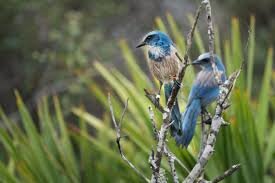Florida Scrub-Jay
Florida’s Incredible Biodiversity
Florida boasts not only beautiful beaches and brilliant sunsets but also boundless biodiversity. It is one of the most biodiverse states in the U.S., ranking among the top five in endemic species (plants and animals found nowhere else). Unfortunately, with so many unique species and continual expansion into their territory, Florida also ranks among the top five states at risk for species extinction.
This includes species like the gopher tortoise, some of which reside in the Florida Wildlife Corridor. The Florida Wildlife Corridor encompasses 18 million acres of land where protection and preservation of local species are occurring in cooperation with local farmers and ranchers. Sadly, despite recent measures of protection, gopher tortoises are still currently listed as Threatened within the state.
Preservation of the different ecosystems in Florida, particularly the scrubland, is vital for the subsistence of the gopher tortoise, hundreds of other species, and ultimately, continuous biodiversity.
Biodiversity goes beyond a simple tally of various plants and animals — it is necessary for the survival of all living things. Every species works together to maintain balance and support life, meaning biodiversity provides clean water, food, medicine, and shelter.
But what does this look like for the gopher tortoise and its scrubland compatriots?
The Unique Florida Scrub Habitat
Florida’s scrub habitat occurs on coastal dunes and interior sandy ridges. These ecoregions are located in Central Florida, Southern Florida, and small stretches along the Gulf Coast. Although scrub makes up only a fraction of the Florida Wildlife Corridor, this unique environment is home to at least 40 endemic species. This number is rather astounding, considering how inhospitable scrub environments appear at first glance.
Scrubs are areas dominated by shrubs, although Florida scrubs are characterized by barren, sandy patches of ground devoid of vegetation. Plants that do manage to grow in “Florida’s desert” are indeed low-growing shrubs; saw palmettos are a common sight in the scrubland, along with woody shrubs such as sand live oak, Chapman’s oak, and myrtle oak. Some Florida scrub is graced with a beautiful canopy of evergreen sand pines. Some scholars argue that these canopied areas should be considered forests rather than scrub.
In the uncanopied scrubland, temperatures can be brutally hot, rainwater rushes through the sterile sands, abrasive winds shift the sand into burying entire shrubs, and fires periodically burn the area to a crisp. (Believe it or not, such fires are healthy and necessary for the scrub, eliminating overgrowth that chokes out other plants, such as the grasses used for food by gopher tortoises.)
While this habitat seems utterly unforgiving, gopher tortoises, endemic scrub-jays, indigo snakes, scrub lizards, and sand skinks thrive in the scrub community.
The warmer temperatures of the exposed scrub are beneficial for the gopher tortoise, as they utilize sunny days for basking (a thermoregulating practice for cold-blooded species). The open spaces provide optimal nesting areas with ideal egg incubation temperatures. Additionally, the sugar-white sands are ideal for the tortoises because their favorite pastime (aside from eating) is burrowing.
With their scaly, shovel-shaped forelimbs, these intrepid excavators dig burrows that can descend ten feet beneath the surface and extend outward as far as 40 feet in length. The burrows help protect the tortoise from both predators and extreme temperatures. But they aren’t the only ones who like to hunker down in the shady tunnels. Gopher tortoises could easily symbolize genuine “Southern hospitality” because they share their burrows with 350 other species, including the adorable endemic Florida mouse.
Because so many other species rely upon the work of the gopher tortoise for food and shelter, the tortoise is considered a keystone species. Specifically, gopher tortoises fall into the keystone subcategory of “ecosystem engineers,” meaning they help maintain the landscape and organisms around them, ultimately defining and preserving the biodiversity of the scrub. If they were removed from their niche in the Florida Wildlife Corridor, it would create a (detrimental) chain reaction throughout the ecoregion. In fact, without the gopher tortoise, some of Florida’s endemic species would go extinct.
Unfortunately, gopher tortoise numbers have declined, with an estimated 700,000 left in the wild — less than a third of their population a century ago. Habitat loss is the number one cause of this decline. (Unfortunately, humans also prefer to build in places that are high and dry.) And like box turtles throughout the United States, gopher tortoises are also highly vulnerable in the face of traffic, and vehicle-related incidents are a significant contributor to tortoise deaths.
The Importance of Conservation Efforts in Florida
Thankfully, the state of Florida has taken steps to help protect the sweet-faced gopher tortoise and thereby the biodiversity of the scrub habitat, too. The tortoises and their burrows are protected under state law, and special management plans have been put in place to help restore the population. The management plans include state acquisition/protection of imperiled habitats and restoring degraded land to become suitable for gopher tortoises once again. Once current habitats are acquired, prescribed fires, timber thinning, mowing, and ground cover restoration will be carried out by human hands to help keep that habitat optimal for resident gopher tortoises.
Working together to follow a strong conservation strategy, Floridians hope to keep the gopher tortoise from ever reaching Endangered status, and in fact, return it to a place of “Least Concern.” This will secure the future of this beautiful creature and the biodiversity of the Florida scrub.
“We must preserve…the gopher tortoise and other species in similar predicaments, for if we do not, we lose a part of our humanity, a part of our habitat, and ultimately our world.”
— Dr. George W. Folkerts, Auburn University, Alabama
Additional Resources
Christman, Steven P., and Walter S. Judd. “NOTES ON PLANTS ENDEMIC TO FLORIDA SCRUB.” Florida Scientist, vol. 53, no. 1, 1990, pp. 52–73. JSTOR, www.jstor.org/stable/24320380. Accessed 3 Sept. 2021.


